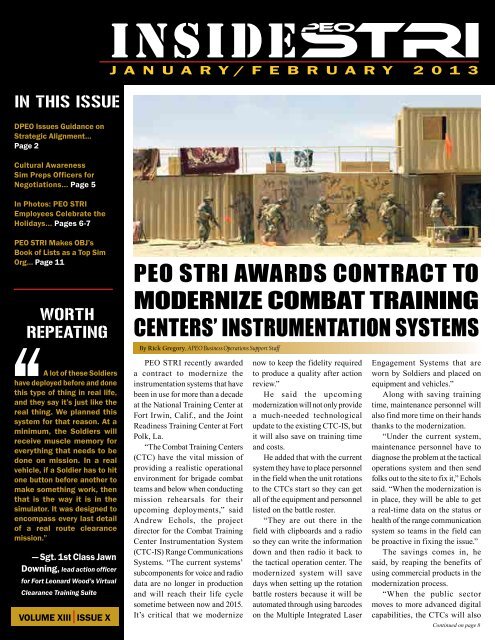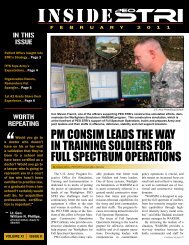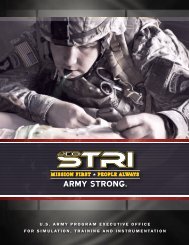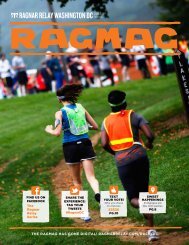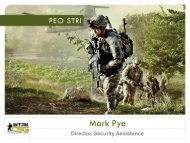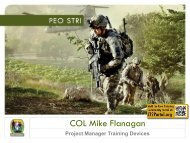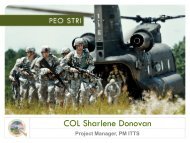InsideSTRI Jan-March 2013 - PEO STRI - U.S. Army
InsideSTRI Jan-March 2013 - PEO STRI - U.S. Army
InsideSTRI Jan-March 2013 - PEO STRI - U.S. Army
Create successful ePaper yourself
Turn your PDF publications into a flip-book with our unique Google optimized e-Paper software.
In this Issue<br />
D<strong>PEO</strong> Issues Guidance on<br />
Strategic Alignment...<br />
Page 2<br />
Cultural Awareness<br />
Sim Preps Officers for<br />
Negotiations... Page 5<br />
In Photos: <strong>PEO</strong> <strong>STRI</strong><br />
Employees Celebrate the<br />
Holidays... Pages 6-7<br />
Inside<br />
JANUARY/FEBRUARY <strong>2013</strong><br />
<strong>PEO</strong> <strong>STRI</strong> Makes OBJ’s<br />
Book of Lists as a Top Sim<br />
Org... Page 11<br />
Worth<br />
Repeating<br />
<strong>PEO</strong> <strong>STRI</strong> Awards Contract to<br />
Modernize Combat Training<br />
Centers’ Instrumentation Systems<br />
By Rick Gregory, A<strong>PEO</strong> Business Operations Support Staff<br />
A lot of these Soldiers<br />
have deployed before and done<br />
this type of thing in real life,<br />
and they say it’s just like the<br />
real thing. We planned this<br />
system for that reason. At a<br />
minimum, the Soldiers will<br />
receive muscle memory for<br />
everything that needs to be<br />
done on mission. In a real<br />
vehicle, if a Soldier has to hit<br />
one button before another to<br />
make something work, then<br />
that is the way it is in the<br />
simulator. It was designed to<br />
encompass every last detail<br />
of a real route clearance<br />
mission.”<br />
— Sgt. 1st Class Jawn<br />
Downing, lead action officer<br />
for Fort Leonard Wood’s Virtual<br />
Clearance Training Suite<br />
VOLUME XIII ISSUE X<br />
<strong>PEO</strong> <strong>STRI</strong> recently awarded<br />
a contract to modernize the<br />
instrumentation systems that have<br />
been in use for more than a decade<br />
at the National Training Center at<br />
Fort Irwin, Calif., and the Joint<br />
Readiness Training Center at Fort<br />
Polk, La.<br />
“The Combat Training Centers<br />
(CTC) have the vital mission of<br />
providing a realistic operational<br />
environment for brigade combat<br />
teams and below when conducting<br />
mission rehearsals for their<br />
upcoming deployments,” said<br />
Andrew Echols, the project<br />
director for the Combat Training<br />
Center Instrumentation System<br />
(CTC-IS) Range Communications<br />
Systems. “The current systems’<br />
subcomponents for voice and radio<br />
data are no longer in production<br />
and will reach their life cycle<br />
sometime between now and 2015.<br />
It’s critical that we modernize<br />
now to keep the fidelity required<br />
to produce a quality after action<br />
review.”<br />
He said the upcoming<br />
modernization will not only provide<br />
a much-needed technological<br />
update to the existing CTC-IS, but<br />
it will also save on training time<br />
and costs.<br />
He added that with the current<br />
system they have to place personnel<br />
in the field when the unit rotations<br />
to the CTCs start so they can get<br />
all of the equipment and personnel<br />
listed on the battle roster.<br />
“They are out there in the<br />
field with clipboards and a radio<br />
so they can write the information<br />
down and then radio it back to<br />
the tactical operation center. The<br />
modernized system will save<br />
days when setting up the rotation<br />
battle rosters because it will be<br />
automated through using barcodes<br />
on the Multiple Integrated Laser<br />
Engagement Systems that are<br />
worn by Soldiers and placed on<br />
equipment and vehicles.”<br />
Along with saving training<br />
time, maintenance personnel will<br />
also find more time on their hands<br />
thanks to the modernization.<br />
“Under the current system,<br />
maintenance personnel have to<br />
diagnose the problem at the tactical<br />
operations system and then send<br />
folks out to the site to fix it,” Echols<br />
said. “When the modernization is<br />
in place, they will be able to get<br />
a real-time data on the status or<br />
health of the range communication<br />
system so teams in the field can<br />
be proactive in fixing the issue.”<br />
The savings comes in, he<br />
said, by reaping the benefits of<br />
using commercial products in the<br />
modernization process.<br />
“When the public sector<br />
moves to more advanced digital<br />
capabilities, the CTCs will also<br />
Continued on page 8
U.S. <strong>Army</strong> <strong>PEO</strong> <strong>STRI</strong><br />
Photo/Doug Schaub<br />
Rob Reyenga<br />
Deputy Program Executive<br />
Officer for <strong>PEO</strong> <strong>STRI</strong><br />
From the Desk of the D<strong>PEO</strong>:<br />
Continued Success is in Your Hands<br />
By Rob Reyenga, Deputy Program Executive Officer for <strong>PEO</strong> <strong>STRI</strong><br />
The <strong>PEO</strong> <strong>STRI</strong> leadership team understands that the<br />
<strong>Army</strong> is in a period of transition, moving away from an<br />
era of sustained combat operations toward the <strong>Army</strong> of<br />
2020, one that’s mission tailored and regionally aligned.<br />
Strategic decisions being made at the “Big <strong>Army</strong>”<br />
level have direct implications on our operations at <strong>PEO</strong><br />
<strong>STRI</strong>. We’re all aware of the guidance coming from the<br />
Department of the <strong>Army</strong> on sequestration, reduced<br />
resources and tough choices. The coming months will<br />
be challenging as we reevaluate ourselves in this resourceconstrained<br />
environment while the demands of our<br />
customers remain the same.<br />
Strategy<br />
STRATEGIC ALIGNMENT<br />
What does the word “alignment” mean to you? To<br />
an infantryman, it might mean the alignment of his sights<br />
on his M4 Carbine. To a mechanic, it might mean the<br />
alignment of the tires on a car. Webster defines alignment<br />
as the “proper positioning or state of adjustment of parts<br />
in relation to each other.”<br />
But, what does it mean to <strong>PEO</strong> <strong>STRI</strong> as an<br />
organization?<br />
MISSION FIRST<br />
At a recent senior leader meeting, our PMs,<br />
A<strong>PEO</strong>s, PARC and chief counsel determined that<br />
in order for us to perform our mission through this<br />
era of increasing resource constraints to the degree<br />
that the <strong>Army</strong> has come to expect, we must take a<br />
hard look at our organizational alignment.<br />
While we’re laser-focused on our mission – which<br />
reads, “acquiring and sustaining training, testing<br />
and simulation solutions in support of the Nation”<br />
– we understand that now, more than ever, we must<br />
invest in you, our people. Day-in and day-out, you<br />
are the ones that make up the acquisition teams who<br />
deliver comprehensive, cost-effective solutions for<br />
the Warfighter.<br />
Processes<br />
Customers<br />
CUSTOMER FOCUSED<br />
In the coming months, I want to introduce you to an<br />
“Alignment Framework” that the senior leaders across<br />
the organization are using to help shape the decisions<br />
we make, the policies and processes we put in place, and<br />
the work that we take on in the coming years.<br />
It’s a tool to help us pull our strategy, people,<br />
processes and customers’ needs together for better<br />
alignment. And the key enabler to make that happen<br />
is you.<br />
People<br />
U.S. <strong>Army</strong> Graphic/<strong>PEO</strong> <strong>STRI</strong><br />
<strong>PEO</strong> <strong>STRI</strong> has adopted the alignment model described in the book, “The<br />
Power of Alignment: How Great Companies Stay Centered and Accomplish<br />
Extraordinary Things,” by George Labovitz and Victor Rosansky.<br />
A TEAM EFFORT<br />
It is important for you to understand this<br />
framework and always ask yourself, “Is this enabling<br />
the acquisition teams in <strong>PEO</strong> <strong>STRI</strong> to deliver the<br />
very best training and testing capabilities for our<br />
customers?”<br />
For the answer to be yes, we must all be aligned:<br />
PMs, the Acquisition Center and <strong>PEO</strong> staff.<br />
In the next article, I’ll layout our plans for gathering<br />
feedback from our customers in order to better align<br />
our business processes with our customers.<br />
2<br />
Inside <strong>STRI</strong> january/february <strong>2013</strong>
New Range System Passes Test<br />
By Mike Casey, Combined Arms Center-Training Public Affairs Officer<br />
A new Location of Miss and Hit (LOMAH)<br />
electronic shot detection and location system<br />
recently passed its Government Acceptance<br />
Test (GAT).<br />
The LOMAH system tracks rounds fired<br />
on or near targets to support Basic Rifle<br />
Marksmanship (BRM) training strategies. The<br />
new system improves rifle range efficiency,<br />
increases training effectiveness and saves time<br />
for commanders and Soldiers.<br />
The LOMAH uses acoustic sensors to detect<br />
hits or misses on or within a two-meter radius of<br />
a target. Then sensors at the target emplacement<br />
relay the results to an android-based tablet at the<br />
firing point. LOMAH automatically triangulates<br />
the shot group to provide the shooter with<br />
corrective data.<br />
“LOMAH will provide immediate feedback<br />
to Soldiers to help them improve their shooting<br />
skills,” said Matt Golden, chief of the Targetry<br />
Development Team for TCM-Live at Joint Base<br />
Langley-Eustis, Va.<br />
In the GAT at Fort Benning, Ga., and Fort<br />
Leonard Wood, Mo., the system successfully<br />
detected hits and misses for targets at 75 meters,<br />
175 meters and 300 meters.<br />
At Fort Benning, Charlie Company, 3rd<br />
Battalion, 81st Armor Regiment provided<br />
support during all phases of testing and was<br />
instrumental in its success. The company is also<br />
the sponsor for the range and will continue to be<br />
actively involved with the LOMAH system as<br />
the range cadre for Armor Regiment and Cavalry<br />
One Station Unit Training BRM.<br />
The LOMAH system is designed for the M16/<br />
M4 series weapons with iron sights, back-up iron<br />
sights, close combat optic or advanced combat<br />
optical gun sights. It can be used for BRM and<br />
Advanced Rifle Marksmanship (ARM).<br />
The test also demonstrated how LOMAH<br />
makes rifle ranges more efficient. An active-duty<br />
platoon from Charlie Troop, 3rd Squadron, 1st<br />
Cavalry Regiment, 3rd Infantry Division took<br />
part in the LOMAH GAT at Fort Benning.<br />
The platoon used the LOMAH range to<br />
conduct three marksmanship tasks on one<br />
range. Tasks included: grouping and zeroing<br />
(at distance), practicing qualification and<br />
qualification versus using three different ranges<br />
to complete the task of zeroing (at 25 meters),<br />
and confirming zero at distance (normally<br />
conducted on Known Distance Range) and<br />
qualifying.<br />
All tasks were accomplished using standard<br />
qualification targets.<br />
“LOMAH will save time by allowing Soldiers<br />
to qualify more quickly,” Golden said.<br />
For example, it would take a unit three days<br />
and three ranges to zero at 25 meters, confirm<br />
zero on the Known Distance (KD) Range and<br />
qualify on an automated record fire range or<br />
modified record fire range.<br />
The LOMAH system embedded on a<br />
qualification range will allow all three tasks to<br />
be completed on one range. Soldiers move more<br />
quickly through the tasks because each lane is<br />
run independently and shooters can progress to<br />
U.S. <strong>Army</strong> Photo<br />
A trooper from Charlie Troop, 3rd Squadron, 1st Cavalry Regiment, 3rd Infantry Division uses the<br />
new Location of Miss and Hit system on the Fowler Range at Fort Benning, Ga.<br />
U.S. <strong>Army</strong> <strong>PEO</strong> <strong>STRI</strong> Photo/PM TRADE<br />
PM TRADE’s target modernization team conducts a Location of Miss and Hit targetry demonstration<br />
at Joint Base Langley-Eustis, Va., Feb. 5 for Brig. Gen. Mike Lundy, deputy commanding general of<br />
Combined Arms Center-Training.<br />
the next task. The LOMAH range has no need<br />
for a detail to raise and lower targets to show<br />
shooters their performance as currently required<br />
on KD ranges.<br />
This fiscal year, the new LOMAH system<br />
will be added to Fort Jackson, S.C.<br />
The program is overseen by TRADOC<br />
Capability Manager-Live (TCM-Live), which<br />
is the <strong>Army</strong> agent for the Sustainable Range<br />
Program and other programs. The materiel<br />
developer for LOMAH is the Project Manager<br />
for Training Devices (PM TRADE), the live<br />
training office at <strong>PEO</strong> <strong>STRI</strong>.<br />
Inside <strong>STRI</strong> <strong>Jan</strong>uary/february <strong>2013</strong><br />
3
First Flight of the “Penguin” for OHISS<br />
By Bobby Ryan, PM ITTS Systems Engineer<br />
PM ITTS’ Objective Helicopter Icing Spray<br />
System (OHISS) program reached a significant<br />
landmark when the “penguin” was lifted onto its<br />
test stand for the first time. The penguin, as it<br />
is called, is the CH-47D fuselage, a component<br />
of the OHISS project used for ground testing.<br />
When the fuselage was first delivered to<br />
the OHISS’ prime contractor, many speculated<br />
about what the object was. The final consensus<br />
was that the fuselage was actually a submarine.<br />
The name penguin stuck because, much like the<br />
fuselage, the bird is flightless, but swims well.<br />
In the coming months, the penguin will be<br />
outfitted with a structural boom that will hang<br />
below the fuselage for which water nozzles<br />
will be installed. When the OHISS is fielded,<br />
these nozzles will be used to spray water and<br />
create a cloud that can be used to test icing<br />
effects on aircraft. By using the test stand,<br />
the contractor will be able to statically install,<br />
deploy and recover the OHISS Spray Boom, and<br />
provide initial test and stress data to the Aviation<br />
Engineering Directorate without the risking a<br />
fleet CH-47F aircraft doing initial test flights.<br />
The method will also be a cost-saving<br />
measure since structural, vibration and boom<br />
demonstration tests can be conducted at the prime<br />
contractor’s site in Columbus, Ohio, without<br />
U.S. <strong>Army</strong> <strong>PEO</strong> <strong>STRI</strong> Photo/PM ITTS<br />
The “penguin,” a CH-47D fuselage, gets lifted onto the test stand for the first time in Columbus,<br />
Ohio, as part of the Objective Helicopter Icing Spray System project.<br />
spending money to ship the boom to Redstone<br />
Test Center in Huntsville, Ala. The OHISS will<br />
require extensive testing on the ground before<br />
it can be cleared for flight, and the height of the<br />
test stand will allow for easy deployment and<br />
retraction of the boom, which at full extension is<br />
approximately 50 feet long. Using the test stand,<br />
the penguin will serve as a risk reduction tool<br />
when integrating the OHISS Cloud Generation<br />
Boom into the CH-47 airframe, and allow the<br />
contractors to quickly and efficiently address<br />
any issues that arise during tests.<br />
‘Attitude’ Survey Now Open to DA Civilian Workforce<br />
By Hank Minitrez, U.S. <strong>Army</strong> News<br />
The <strong>Army</strong> Civilian Attitude Survey, the<br />
<strong>Army</strong>’s primary attitude and opinion poll of<br />
its DA civilian workforce, is open by email<br />
invitation worldwide.<br />
The online survey, which opened Feb. 3,<br />
aims to confidentially tackle tough questions on<br />
job satisfaction, performance management and<br />
other topics. To date, more than 40,000 civilian<br />
employees have responded to the survey.<br />
“A survey is one of the few ways a<br />
commander can gauge the pulse of what’s going<br />
on in their command workforce,” said Murray<br />
Mack, from the Office of the Assistant G-1 for<br />
Civilian Personnel. “Surveys really fill the need<br />
for reliable information.”<br />
The survey has been administered every<br />
few years since 1977. In the past, the <strong>Army</strong><br />
could only poll a small random sample of the<br />
civilian workforce due to the cost of survey<br />
administration. Through recent technology, the<br />
entire <strong>Army</strong> civilian workforce, including foreign<br />
nationals – more than 250,000 personnel – are<br />
U.S. <strong>Army</strong> Photo/C. Todd Lopez<br />
The <strong>Army</strong> Civilian Attitude Survey, the <strong>Army</strong>’s<br />
primary attitude and opinion poll of its Department<br />
of the <strong>Army</strong> Civilian workforce, is open by email<br />
invitation worldwide.<br />
now invited to participate via the <strong>Army</strong> Training<br />
Requirements and Resources System survey tool.<br />
Survey feedback reports are prepared for<br />
every <strong>Army</strong> organization that contains at least<br />
50 people with at least 10 people responding.<br />
The reports will be distributed approximately<br />
six weeks following the end of the survey<br />
administration period, on or about <strong>March</strong><br />
31, <strong>2013</strong>.<br />
Mack expects a high response level this<br />
year due to civilian workforce concerns such<br />
as the impact of pending budget reductions<br />
and the sequestration. While the timing of<br />
the survey may not be the best, gathering this<br />
information will be beneficial for employees<br />
and the <strong>Army</strong>, he said.<br />
While the answers about employees’ work<br />
environments may give commanders insight<br />
into opinions, it is up to commanders and<br />
senior leaders to make changes when necessary.<br />
Leaders often use the information gathered<br />
from the surveys to hold focus groups with their<br />
employees to obtain additional information.<br />
“A survey can’t tell you why people responded<br />
the way they did; it will only tell you how they<br />
responded,” Mack said.<br />
The survey has a core set of questions<br />
in order to track employee trends over time,<br />
but questions pertaining to current issues are<br />
added with each survey administration, such as<br />
telework and alternative work schedules.<br />
4<br />
Inside <strong>STRI</strong> january/february <strong>2013</strong>
Game-based Simulator Prepares Soldiers<br />
for Culturally Sensitive Meetings<br />
By Rick Gregory, Business Operations Office Support Staff<br />
Imagine going to a meeting set up on your<br />
Microsoft Outlook calendar and you are told to<br />
abide by a list of meeting parameters.<br />
“Arrive on time, but expect to wait.”<br />
“Speak only when spoken to and do not<br />
discuss anything specific until refreshments<br />
and small talk have been offered.”<br />
“Be sure to inquire as to how things are going<br />
in the lives of the attendees.”<br />
“Do not shake hands with attendees of the<br />
opposite gender.”<br />
“Once a relationship is established at the<br />
meeting, expect same-gender hugs or even<br />
three kisses.”<br />
Those meeting parameters are probably<br />
enough to cause most people to keep their<br />
Outlook “Out of Office” message active.<br />
They are actually just a small part of the<br />
cultural awareness that <strong>Army</strong> officers have<br />
to become acutely aware of when conducting<br />
negotiation meetings with tribal leaders in<br />
Afghanistan. One seemingly insignificant breach<br />
of the cultural etiquette during the meetings can<br />
send the negotiations into a tailspin and set the<br />
much-needed bilateral cooperation on a reverse<br />
course. Negotiation skills are critical to <strong>Army</strong><br />
officers in Afghanistan as they spend hours with<br />
tribal leaders sipping tea while they discuss a<br />
range of issues that, when handled properly, can<br />
be even more effective in the war efforts than<br />
engaging the enemy in combat.<br />
As pointed out in a USA Today article titled,<br />
“The <strong>Army</strong>’s secret weapon: negotiation,” an<br />
alliance between local tribal leaders and the U.S.<br />
military helped drive Al Qaeda from Ramadi,<br />
Iraq in 2006. It was a turning point in the war.<br />
While in-class training is available to<br />
help prepare Soldiers who may be faced with<br />
negotiation tasks on upcoming deployments,<br />
<strong>PEO</strong> <strong>STRI</strong> fields a game-based computer<br />
simulation called the Bilateral Negotiation<br />
Trainer (BiLAT) that provides users a practice<br />
environment for conducting bilateral meetings<br />
and negotiations in a cultural context.<br />
Leslie Dubow, <strong>PEO</strong> <strong>STRI</strong>’s project director<br />
for the Games for Training program of record,<br />
said BiLAT has two applications that combine<br />
to provide the user with negotiations and culture<br />
training – BiLAT AIDE and ELECT BiLAT.<br />
ELECT is an acronym for Enhanced Learning<br />
Environments with Creative Technologies.<br />
U.S. <strong>Army</strong> Graphic<br />
The Bilateral Negotiation Trainer is a game-based system designed to aide <strong>Army</strong> officers in rehearsing<br />
for culturally sensitive meetings and negotiations.<br />
“BiLAT AIDE is an hour-long Microsoft<br />
PowerPoint presentation that provides the users<br />
with the principles and procedures of culturalbased<br />
negotiations,” she explained. “The videos<br />
embedded in the presentation demonstrate<br />
several scenarios where actors demonstrate good<br />
and bad negotiation preparation, planning and<br />
execution. It’s basically the primer before going<br />
on to ELECT BiLAT.”<br />
Once logged in, ELECT BiLAT presents the<br />
option for the user to select from any of seven<br />
unique scenarios, Dubow said.<br />
“After selecting the scenario, the user will<br />
be given the mission objective, such as building<br />
better relationships with the tribal counterparts.<br />
They are then provided the names and a brief<br />
background on a few key local individuals who<br />
the user can choose to meet with to conduct the<br />
bilateral negotiations that relate to the mission<br />
objective,” she explained.<br />
From there, the BiLAT user is presented with<br />
several options before going straight into the<br />
meeting with the selected individual.<br />
They are given an opportunity to conduct<br />
research from a variety of sources to assist in<br />
building a meeting preparation sheet; taking<br />
a cultural quiz to earn additional time to<br />
accomplish the mission; selecting and practicing<br />
with a computer-generated (avatar) interpreter;<br />
or seeing the unit executive officer to help build<br />
meeting actions and conduct a rehearsal. The<br />
user can choose any or all of the options or<br />
simply choose to go straight into the meeting.<br />
Once into the actual meeting with the<br />
selected local leaders, the user must establish a<br />
relationship and be mindful of the characters’<br />
cultural sensitivities. Negotiations can go well<br />
or poorly based on how the user interacts with<br />
the avatars.<br />
“After the meeting has concluded, the<br />
user receives feedback during an after-action<br />
review on their performance,” Dubow said.<br />
“This process is repeated until the user is able<br />
to meet their mission objectives through effective<br />
bilateral negotiations with all of the key local<br />
individuals associated with the chosen scenario.”<br />
BiLAT is available to CAC or AKO users via<br />
the login at https://milgaming.army.mil.<br />
Bilateral Training is a Multilateral Effort<br />
BiLAT is a collaboration between the University of Southern California’s Institute for Creative<br />
Technologies, U.S. <strong>Army</strong> Research Institute for the Behavioral and Social Sciences, U.S.<br />
<strong>Army</strong> Research Laboratory Human Research and Engineering Directorate and U.S. <strong>Army</strong><br />
Research Laboratory’s Simulation and Training Technology Center.<br />
Inside <strong>STRI</strong> <strong>Jan</strong>uary/february <strong>2013</strong><br />
5
HOLIDAY CEL<br />
AROUND<br />
Business Operations Office employees<br />
enjoy their first place ranking during the<br />
BOO holiday party Dec. 14 at the Oviedo<br />
Bowling Center.<br />
Col. Sharlene Donovan of PM ITTS spends time<br />
with her staff during the organization’s Christmas<br />
luncheon and gift exchange.<br />
PM CATT employees participate in<br />
a “Best Christmas Tree” contest<br />
during their holiday celebrations.<br />
PM TRADE employees celebrate<br />
the holidays during a Dec. 13<br />
gathering at the Holiday Inn.<br />
Rob Miller, Jean Burmester and Mollie Graham get into<br />
the holiday spirit during the Project Support Group’s<br />
holiday lunch at the Mellow Mushroom.<br />
Michele G<br />
enjoy lunc<br />
during the<br />
holiday lun<br />
6<br />
Inside <strong>STRI</strong> january/february <strong>2013</strong>
PM ITTS employees celebrate the<br />
holidays together Dec. 7 over lunch<br />
and a gift exchange.<br />
Business Operations Office<br />
employees play a round of<br />
“Holiday Scatagories” during<br />
the BOO Ugly Sweater Party.<br />
EBRATIONS<br />
<strong>PEO</strong> <strong>STRI</strong><br />
Moe Reshad of PM CATT dresses<br />
festive for the organization’s<br />
holiday luncheon.<br />
The PM ConSim team<br />
gathers for a holiday<br />
photo in Warfighter Park.<br />
A team from PM TRADE distribute<br />
homemade cookies at the Veterans<br />
Home Medical Facility Dec. 11,<br />
marking the second consecutive<br />
year they spread “sweet” holiday<br />
cheer to military vets.<br />
entile (left) and Traci Jones<br />
h at the Mellow Mushroom<br />
Project Support Group’s<br />
cheon.<br />
PM ConSim celebrates the<br />
holidays with a Dec. 19 potluck<br />
meal in Partnership III.<br />
U.S. <strong>Army</strong> Photos<br />
Inside <strong>STRI</strong> <strong>Jan</strong>uary/february <strong>2013</strong><br />
7
ACCEPTING NOMINATIONS NOW<br />
for outstanding members of the <strong>Army</strong> acquisition workforce<br />
U.S. <strong>Army</strong> Acquisition Support Center presents<br />
What is Faces of the Force?<br />
Faces of the Force is a biweekly online<br />
feature providing an opportunity to highlight<br />
members of the <strong>Army</strong> acquisition workforce. It is<br />
produced by the U.S. <strong>Army</strong> Acquisition Support<br />
Center Strategic Communication Division. Every<br />
other week, USAASC features a Soldier or civilian<br />
currently serving in a variety of AL&T disciplines.<br />
Who is eligible?<br />
Any AL&T Soldier or civilian who deserves recognition for what<br />
they do every day.<br />
How do I nominate someone?<br />
Request a nomination form from the <strong>PEO</strong> <strong>STRI</strong> Public Affairs<br />
Office at Public_Affairs@peostri.army.mil. The <strong>PEO</strong> <strong>STRI</strong><br />
Public Affairs Office will send the nominations to USAASC for<br />
consideration.<br />
What happens next?<br />
Once a Soldier or civilian is selected, the USAASC Strategic<br />
Communication Division will coordinate with the selectee’s<br />
PAO to clarify any information provided in the nomination<br />
form or to obtain additional details. Additionally, USAASC will<br />
request a photo of the individual and a 20-minute window of<br />
availability during which the selectee can conduct a phone<br />
interview with a member of the USAASC STRATCOM team.<br />
During the interview, the individual will be asked a few follow<br />
up questions to those outlined below. Email interviews can also<br />
be accommodated. After the PAO approves the final designed<br />
product, it will be posted to the front page of the USAASC<br />
website, http://asc.army.mil, and Facebook page.<br />
ACCEPTING NOMINATIONS NOW<br />
INSTRUMENTATION SYSTEMs<br />
continued from cover<br />
transition to those capabilities<br />
with no cost to the government,”<br />
he explained. “Also, the<br />
sustainment costs of having<br />
multiple networks will be<br />
reduced when we field common<br />
subsystems on one network at<br />
each CTC.”<br />
With the modernization,<br />
each Soldier participating in<br />
the mission rehearsal will be<br />
equipped a smartphone. This<br />
will not only provide a substantial<br />
savings, but will also increase the<br />
ability for information sharing<br />
and tracking.<br />
Echols pointed out that<br />
HOLIDAYS<br />
Events<br />
Inside<br />
Inside <strong>STRI</strong> is an authorized publication<br />
for military and civilian members of the<br />
U.S. <strong>Army</strong> Program Executive Office for<br />
Simulation, Training and Instrumentation,<br />
Orlando, Fla. 32826. Inside <strong>STRI</strong> is published<br />
under the authority of AR 360-1 and<br />
applies the Associated Press Stylebook<br />
industry standard.<br />
Contents of Inside <strong>STRI</strong> are not necessarily<br />
the official views of, or endorsed by, the<br />
U.S. Government, Department of Defense,<br />
Department of the <strong>Army</strong>, or <strong>PEO</strong> <strong>STRI</strong>.<br />
Editorial material for publication<br />
should be submitted to <strong>PEO</strong> <strong>STRI</strong> Public<br />
by having the smartphones,<br />
Soldiers will not only be able<br />
to communicate by traditional<br />
means, but they will also be able<br />
to send and receive text message,<br />
pictures and videos.<br />
“The phones also represent<br />
a big savings when having to<br />
replace them when compared<br />
to the radios,” he added. “The<br />
phones can be replaced for a few<br />
hundred dollars each while the<br />
radios cost thousands of dollars<br />
apiece. As well, there will be a<br />
cost avoidance from not having to<br />
have the infrastructure to support<br />
the radio systems.”<br />
<strong>March</strong> 7 ............Town Hall Meeting<br />
<strong>March</strong> 8 .........Brig. Gen. Espaillat’s<br />
Pinning Ceremony<br />
<strong>March</strong> 8 ..SHAPE Basketball Game<br />
<strong>March</strong> 10 ....Daylight Savings Time<br />
<strong>March</strong> 17 .............. St. Patrick’s Day<br />
<strong>March</strong> 31 ..............................Easter<br />
April 11 .....................Diversity Day<br />
April 12 ............................. Org Day<br />
April 18 ..........................Jeans Day<br />
April 23 .......................... Earth Day<br />
Affairs Office, 12350 Research Parkway,<br />
Orlando, Fla. 32826. The PAO reserves<br />
the right to edit all material submitted<br />
for publication.<br />
For more information about <strong>PEO</strong> <strong>STRI</strong><br />
or to view Inside <strong>STRI</strong> online, visit our<br />
website at www.peostri.army.mil<br />
Editor:<br />
Kristen Dooley McCullough, Editor-in-Chief<br />
Kristen.McCullough@us.army.mil<br />
Design:<br />
Dwain Fletcher Co.<br />
CGgraphics@peostri.army.mil<br />
8<br />
Inside <strong>STRI</strong> january/february <strong>2013</strong>
Soldiers from the 157th Infantry Brigade, First <strong>Army</strong> Division East train in the Dismounted Soldier Training System.<br />
Virtual Training Puts the ‘Real’ in Realistic Environment<br />
By Maj. Penny Zamora, 157th Infantry Brigade Public Affairs<br />
In a warehouse looking much like a laser tag<br />
game room, nine Soldiers gear up with flip down<br />
goggle mounts, sensors strapped to their arms<br />
and legs, and each carries a computer-enhanced<br />
weapon system. Just five years ago, this scenario<br />
may have only been seen in a video game. Today,<br />
virtual training environments are a reality.<br />
The Dismounted Soldier Training System,<br />
or DSTS, and Engagement Skills Trainer 2000<br />
are two virtual training tools that are quickly<br />
becoming the norm for Soldiers of the 157th<br />
Infantry Brigade, First <strong>Army</strong> Division East,<br />
in training deploying units at Camp Atterbury<br />
Joint Maneuver Training Center, Ind.<br />
“One of the best parts of the DSTS is we<br />
can create any operational environment, for<br />
our training in a virtual environment. It does<br />
not replace training, but it can add to it. We can<br />
bring the terrain of Afghanistan to the Soldier.<br />
It’s hard to imagine a mountainous terrain in<br />
Indiana, but the DSTS can create it,” said Sgt.<br />
1st Class Aaron Hammond, Operations, 157th<br />
Infantry Brigade, First <strong>Army</strong> Division East.<br />
Hammond and his team recently participated<br />
in a DSTS session to learn the capabilities offered<br />
at the Camp Atterbury Joint Maneuver Training<br />
Center virtual simulation centers. Geared up and<br />
ready to engage in a building entry exercise,<br />
the nine-man squad immediately encountered<br />
and reacted to enemy fire. With one member<br />
quickly disabled, the team had to quickly adjust<br />
tactics, techniques and procedures, and continue<br />
their mission.<br />
“Providing the most realistic and relevant<br />
training is the benchmark for success in First<br />
<strong>Army</strong> Division East when training Soldiers<br />
for worldwide deployments. Our job is to<br />
replicate situations in which the Soldier will<br />
face and to create an environment to rehearse<br />
repetitively at the squad or team level,” said<br />
Capt. Marcus Long, 157th Infantry Brigade<br />
training officer.<br />
Each Soldier stands on a four-foot diameter<br />
rubber pad. This pad is the center of a 10-<br />
foot by 10-foot training area for each squad<br />
member, and the pad ensures Soldiers remain in<br />
a specific area within the training suite. Soldiers<br />
can see and hear the virtual environment and<br />
also communicate with members of the squad<br />
using a helmet-mounted display with headphone/<br />
microphone set.<br />
“A Soldier uses his body to perform<br />
maneuvers, such as walking or throwing a hand<br />
grenade, by physically making those actions. The<br />
sensors capture the Soldier’s movements, and<br />
those movements are translated to control the<br />
Soldier’s avatar within the simulation,” explained<br />
Matthew Roell, DSTS operator.<br />
With a few computer commands, operators<br />
reset the virtual environment. This time the<br />
U.S. <strong>Army</strong> Photo<br />
squad encounters enemy fire and a mortar<br />
attack. The squad calls for and receives close air<br />
support and successfully negotiates the building<br />
entry task.<br />
“Each unit that comes through Camp<br />
Atterbury cannot receive close air support or<br />
call for artillery fire in live training, but we can<br />
create any simulated operational environment,<br />
desert or jungle, with any weapons system and<br />
any number of enemy forces with a few key<br />
strokes,” said Brandon Roell, DSTS technician.<br />
“This simulated training is the future of<br />
training. The DSTS allows a Soldier to wear<br />
the simulation instead of sitting inside of a<br />
simulator,” said Roell.<br />
As with any exercise, the after-action<br />
review, or AAR, is a critical step in helping<br />
units identify strengths and weaknesses. The<br />
DSTS provides a complete digital playback<br />
of a scenario from several vantage points.<br />
The operator can switch the playback from<br />
a third person view or worldview. During<br />
the AAR, First <strong>Army</strong> Division East trainer/<br />
mentors use the different views to illustrate<br />
specific actions.<br />
“Looking at each type of view, leaders can<br />
evaluate individual movement and actions, as<br />
well as the group as a whole. We cannot get<br />
this in-depth and multifaceted view during an<br />
Continued on page 11<br />
Inside <strong>STRI</strong> <strong>Jan</strong>uary/february <strong>2013</strong><br />
9
Question:<br />
<strong>PEO</strong> <strong>STRI</strong> was recognized in November<br />
2012 by Florida’s Blood Centers for<br />
their substantial blood donations over<br />
the past few years. Why do you think<br />
it’s important to donate blood?<br />
Potential Lean Six Sigma Black<br />
Belts Meet Required Training,<br />
Start Improvement Projects<br />
By John Kirch, <strong>PEO</strong> <strong>STRI</strong> Chief Financial Manager and Lean Six Sigma Deployment Director<br />
Jill Edwards,<br />
Acquisition Center<br />
“When I first started<br />
donating over 25 years<br />
ago, I just felt good<br />
about being able to give<br />
back to my community.<br />
My dad battled leukemia<br />
for three and a half<br />
years, and regularly<br />
received blood and<br />
platelets before recently passing away. This<br />
was my way of helping him. He required more<br />
units than I care to think about, but I feel like the<br />
blood I donated helped someone else in need,<br />
possibly in a similar situation. So as long as I<br />
can, I will continue to donate blood in hopes<br />
of helping someone live longer.”<br />
Melissa Ruping,<br />
PM TRADE<br />
“I have the rarest<br />
type of blood – AB<br />
Negative – and less<br />
than one percent of the<br />
population has this type<br />
of blood. When my son<br />
was born, we found out<br />
that his blood type is<br />
the same as mine. From<br />
that day forward, I started giving blood just in<br />
case he ever needed it. This is my stewardship<br />
as a Christian, I thank God every day that he has<br />
not needed it; and I’m happy that I have helped<br />
save severe burn and hemorrhage patients.”<br />
Hal Spaulding,<br />
PSG<br />
Giving blood is easy,<br />
and when people<br />
need blood, it is often<br />
a desperate need. A<br />
small effort on my part<br />
as a donor can mean<br />
a lot on the receiving<br />
end.<br />
Want your opinion heard? Answer <strong>March</strong>’s Question!<br />
The question is open to the entire workforce.<br />
With sequestration and continuing resolution affecting<br />
our budget, and the possibility of a civilian furlough,<br />
what keeps your professional morale high?<br />
Send your response to Kristen.McCullough@us.army.mil<br />
and put Citizen <strong>STRI</strong> in the subject line.<br />
<strong>PEO</strong> <strong>STRI</strong> hosted its first <strong>Army</strong> Lean Six<br />
Sigma (LSS) black belt training course that<br />
wrapped up <strong>Jan</strong>. 18. The four-week LSS Black<br />
Belt course teaches and prepares individuals<br />
to implement the principles, practices and<br />
techniques to achieve breakthrough business<br />
improvements for their organizations and<br />
across the <strong>PEO</strong>.<br />
Participants included candidates from both<br />
the <strong>Army</strong> and the Marines, and both civilian<br />
and military members: <strong>Army</strong> Maj. Freeman<br />
Bonnette, Hector Colon, Charlie Goodwin,<br />
Jason Graham, Michael Landers, <strong>Army</strong> Maj.<br />
Tomas Monaghan, <strong>Army</strong> Sgt. Maj. Patrick<br />
Ogden, Nealie Page, Abdul Siddiqui, <strong>Army</strong><br />
Maj. Michael P. Smith and Joann Wesley<br />
Each black belt candidate is trained to<br />
identify opportunities for improvement within<br />
the <strong>PEO</strong> by using of a large number of Lean<br />
Six Sigma methodologies and applying the<br />
correct tools and techniques to their Lean Six<br />
Sigma project.<br />
Credit: U.S. <strong>Army</strong> <strong>PEO</strong> <strong>STRI</strong> Photo/Doug Schaub<br />
<strong>PEO</strong> <strong>STRI</strong>’s first class of prospective <strong>Army</strong> Lean Six Sigma (LSS) black belts completed the required<br />
four-week training session <strong>Jan</strong>. 18 and began working on projects to improve business practices<br />
across the organization. The black belt candidates are pictured with the course instructors, Tom<br />
Wallace and Deananne Snodgrass, Master Black Belt Chris Rozycki and the LSS Development<br />
Director John Kirch.<br />
After completing the training, each black<br />
belt candidate will lead a Lean Six Sigma<br />
project to achieve significant financial and/or<br />
operational improvements for the <strong>PEO</strong>. Each<br />
black belt candidate is mentored by the <strong>PEO</strong>’s<br />
Master Black Belt, Chris Rozycki, who will<br />
guide them through the five stage “Define-<br />
Measure-Analyze-Improve-Control” process.<br />
Upon completion, the project documentation<br />
is sent to the <strong>Army</strong>’s Office of Business<br />
Transformation where the project is reviewed<br />
for adherence to the required use of Lean Six<br />
Sigma tools and principles, and verification<br />
that the projects’ financial and/or operational<br />
benefits have been substantiated by an <strong>Army</strong><br />
Resource Manager.<br />
Upon successful completion of both the<br />
training and project, the candidates will receive<br />
the <strong>Army</strong> Black Belt certification and may<br />
lead future projects and mentor green belt<br />
candidates.<br />
10<br />
Inside <strong>STRI</strong> january/february <strong>2013</strong>
<strong>PEO</strong> <strong>STRI</strong> Selected as Only DoD Agency<br />
in Local ‘Best of the Best’ Rankings<br />
By Kristen A. McCullough, U.S. <strong>Army</strong> <strong>PEO</strong> <strong>STRI</strong> Public Affairs Officer<br />
Central Florida’s simulation and training<br />
industry has helped to sustain the local<br />
economy throughout the past few years of<br />
economic downturn.<br />
An article published Feb. 25 in the Orlando<br />
Business Journal by associate managing<br />
editor Bill Orben cites that, Florida-wide,<br />
the modeling and simulation industry<br />
employs approximately 27,000 people with<br />
an average annual salary of more than $69,000,<br />
resulting in an estimated statewide annual<br />
economic impact of $4.8 billion. The 100<br />
local modeling and simulation companies<br />
employ approximately 12,500 people and bring<br />
a combined revenue of $3 billion annually into<br />
the local economy.<br />
The figures reveal a clear picture of the<br />
economic magnitude that the Department of<br />
Defense’s modeling and simulation agencies<br />
bring to the greater Orlando area. <strong>PEO</strong> <strong>STRI</strong>’s<br />
economic impact was also validated when<br />
the organization was named a top modeling,<br />
simulation and training agency in the Orlando<br />
Business Journal’s (OBJ) <strong>2013</strong> Book of Lists.<br />
“These lists are essential in providing a<br />
quick but thorough resource that allows you<br />
to know at a glance who the business leaders<br />
are in Central Florida, what they specialize<br />
in and how well they performed, as well as<br />
their top officials and contact information,”<br />
Ann Sonntag, OBJ’s publisher, wrote in the<br />
publication’s “Letter from the Publisher.”<br />
Dr. Jim Blake, in honor of <strong>PEO</strong> <strong>STRI</strong>’s<br />
recognition of being named in the Book of Lists,<br />
attended the 28th Annual Book of Lists reception.<br />
“As Congress looks at the Department of<br />
Defense for budget cuts, we believe Central<br />
Photo Courtesy of the Orlando Business Journal<br />
Dr. Jim and Sharon Blake attend the 28th Annual Book of Lists reception in recognition of <strong>PEO</strong> <strong>STRI</strong><br />
being named in the <strong>2013</strong> Book of Lists, the only Department of Defense entity to attain this honor.<br />
Floridians depend on <strong>PEO</strong> <strong>STRI</strong> and its sister<br />
services for both economic stability and saving<br />
taxpayer dollars through the promulgation of<br />
simulated training,” Blake said. “I believe <strong>PEO</strong><br />
<strong>STRI</strong>’s inclusion in the OBJ’s <strong>2013</strong> Book of Lists<br />
is another notch on our belt of accomplishments,<br />
in which every token of success can be attributed<br />
to our world class workforce.”<br />
ENVIRONMENT continued from page 9<br />
actual live training exercise. We can even have<br />
the operator bookmark or tag a specific time<br />
so we can take a closer look during the AAR,”<br />
Long said.<br />
First <strong>Army</strong> Division East trainers also<br />
incorporate the Engagement Skills Trainer 2000,<br />
or EST 2000, into mobilization training.<br />
During individual and sustainment<br />
marksmanship training, Soldiers fire weapons<br />
multiple times while the computer tracks<br />
their progress and provides multiple statistics.<br />
Soldiers wanting to improve accuracy find<br />
this especially helpful. This simulation system<br />
allows Soldiers to gain familiarity with several<br />
types of weapons with minimal resources and<br />
no expenditure of ammunition.<br />
“Nuances that cannot be seen by the eye<br />
affecting accuracy, such as the minute direction<br />
of pull on the trigger, are collected and analyzed<br />
by the trainer,” Hammond said.<br />
“It feels like firing a real M4. When firing<br />
on the zero range, the target is brought up on the<br />
screen to show the results. If the shot group is<br />
tight, the computer makes the adjustment to zero<br />
the weapon. If the shot group is not tight, it gives<br />
us mentor/trainers the opportunity to observe the<br />
Soldier to make sure they are practicing good,<br />
basic marksmanship techniques,” said Sgt. 1st<br />
Class Robert P. Braun, with the Operations<br />
Section, 157th Infantry Brigade.<br />
Soldiers can progress to Squad/Fire Team<br />
Collective Tasks and Judgmental Use of Force<br />
scenarios to hone basic marksmanship skills.<br />
These two scenarios allow Soldiers to engage<br />
targets while working as a team. Once Soldiers<br />
gain proficiency, they progress to the actual<br />
live fire range.<br />
Each unit must understand the different<br />
simulation capabilities and limitations before<br />
scheduling. For example, the DSTS cannot<br />
help with basic marksmanship techniques; it<br />
is designed to enhance squad and team tactics,<br />
while the EST 2000 can specifically aid in<br />
improving marksmanship.<br />
“It’s our job to train Soldiers at the lowest<br />
level. The DSTS and EST 2000 give leaders<br />
and squads a chance to really look at their<br />
tactics, techniques and procedures in a safe,<br />
but realistic environment. Really, the number<br />
of scenarios the operators can create are<br />
unlimited,” said Hammond.<br />
Entering the realm of the virtual environment<br />
is no longer a futurist vision. With the many<br />
different simulations ranging from vehicle<br />
familiarization to fully immersive combat<br />
training scenarios, First <strong>Army</strong> Division East<br />
trainers ensure Soldiers are responsive and<br />
prepared for combatant commanders.<br />
“Here at Camp Atterbury, we’ve only just<br />
scratched the surface of incorporating simulation<br />
trainers for deploying units. As we familiarize<br />
more with these systems, our training capabilities<br />
also improve,” Long said.<br />
Inside <strong>STRI</strong> <strong>Jan</strong>uary/february <strong>2013</strong><br />
11
TEAM ORLANDO in Photos<br />
U.S. <strong>Army</strong> <strong>PEO</strong> <strong>STRI</strong> Photo/<br />
Events Management Office<br />
John Daniele, the acting assistant program<br />
executive officer for customer support who<br />
is responsible for <strong>PEO</strong> <strong>STRI</strong>’s Foreign Military<br />
Sales, facilitates a capabilities presentation<br />
Feb. 20 to representatives of the NATO/Allied<br />
Command Transition Office attached to the<br />
Joint Staff in Suffolk, Va. Foreign military<br />
officers representing Italy, Finland, Germany,<br />
Sweden, Hungary, Romania, Czech Republic,<br />
France, Poland, Turkey, Korea, Japan, Jordan<br />
and Morocco attended the discussion, as<br />
did U.S. military leaders from the Joint Staff<br />
including Brig. Gen. Bradley A. Becker and<br />
Thomas C. Irwin, SES.<br />
U.S. <strong>Army</strong> Photo<br />
<strong>PEO</strong> <strong>STRI</strong> engineers volunteer as judges<br />
in the Seminole County Science Fair Feb.<br />
9, along with engineering and psychology<br />
experts from the <strong>Army</strong> Research Laboratory’s<br />
Human Research Directorate Simulation and<br />
Training Technology Center, Naval Air Warfare<br />
Center Training Systems Division, and Central<br />
Florida Science Technology, Engineering and<br />
Mathematics council. The team of volunteers<br />
judged 70 high school projects, in which one<br />
received the top <strong>Army</strong> medal and four others<br />
receiving honorable mention. Ten of the top<br />
projects advance to the Florida State Science<br />
Fair, and three others will represent Seminole<br />
County at the International Science Fair, both<br />
competitions taking place this spring.<br />
U.S. <strong>Army</strong> Photo<br />
The <strong>Army</strong> Acquisition Executive Heidi Shyu,<br />
assistant secretary of the <strong>Army</strong> for Acquisition,<br />
Logistics and Technology, visits Camp<br />
Buehring in <strong>Jan</strong>uary. While there, she received<br />
an overview of <strong>PEO</strong> <strong>STRI</strong>’s mission in Kuwait,<br />
briefing on the Warfighter FOCUS contract and<br />
tour of the training village from Tom DeLoach,<br />
<strong>PEO</strong> <strong>STRI</strong>’s customer service representative<br />
based in Kuwait.<br />
Courtesy Photo<br />
Jill Biden, Ph.D., wife of Vice President Joe<br />
Biden, receives a demonstration of the<br />
Reconfigurable Vehicle Tactical Trainer Feb.<br />
2 during her visit to Grafenwoehr, Germany.<br />
While at U.S. <strong>Army</strong> Garrison Grafenwoehr,<br />
Biden also read to children at the USO, spoke<br />
with teachers at the Grafenwoehr Elementary<br />
School, visited with military families and<br />
lunched with Soldiers at the dining facility.<br />
As both the second lady and a military mom,<br />
Biden said she is dedicated to creating<br />
awareness and spearheading support for<br />
military families both in the U.S. and those<br />
stationed and deployed overseas.<br />
Courtesy Photo<br />
A ribbon-cutting ceremony is hosted in<br />
<strong>Jan</strong>uary for the new Flight School XXI CH-47F<br />
flight simulator at Warrior Hall in Daleville, Ala.<br />
U.S. <strong>Army</strong> <strong>PEO</strong> <strong>STRI</strong> Photo/PM ITTS<br />
PM ITTS’ Targets Management Office (TMO)<br />
receives multiple accolades from Redstone<br />
Arsenal’s <strong>Army</strong> Contracting Command<br />
(ACC) in a Feb. 1 ceremony. Mary Dickens,<br />
ACC executive director, presented Alvin<br />
Brown with the ACC Competition Award<br />
for TMO’s sustained efforts to provide the<br />
most cost-effective products to meet the<br />
needs of the Warfighter.<br />
12<br />
Inside <strong>STRI</strong> january/february <strong>2013</strong>


